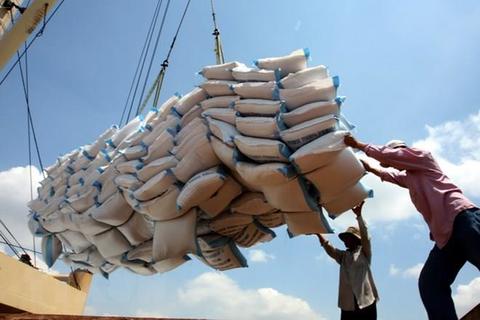
Rice being harvested in Vi Thuy District, Hau Giang Provinve. Prime Minister Nguyen Xuan Phuc has asked for rice to be stockpiled to cope with falling prices. — VNA/VNS Photo Duy Khuong
A Government decree that sought to remove difficulties and legal barriers for rice businesses to boost their exports, which took effect last October, has not impacted rice exports as much as expected, according to exporters.
Le Thanh Khiem, deputy director of the Tien Giang Food Company, told Tuoi Tre (Youth) newspaper that since Decree 107 came into effect there has not been much change in rice exports.
For exports to be good, besides a favourable legal framework the market is also very important, but it is not looking bright, he said.
The An Giang Province Department of Industry and Trade too said rice exports have not increased much after Decree 107 took effect because the market and the performance of enterprises are still the main factors.
Rice exporters said they face difficulties because China, the country’s largest market, has applied measures to restrict imports.
Nguyen Ngoc Nam, general director of the Viet Nam Southern Food Corporation (Vinafood 2) and chairman of the Viet Nam Food Association (VFA), said since the middle of last year China has raised import tariffs on rice from ASEAN member countries to up to 50 per cent from the earlier 5 per cent. As a result Viet Nam’s exports have dropped sharply.
China had earlier asked Viet Nam for a list of rice exporting companies so that it could consider issuing them licenses, which also made it difficult for exports and reduced the number of Vietnamese exporters to this market.
Of 152 rice export companies that are members of the VFA, China buys from only 21, he said.
“As a result, China currently accounts for 22 per cent of Viet Nam’s rice exports compared to over 30 per cent earlier, he added.
Khiem said the Tien Giang Food Company is one of two enterprises in the province permitted to export to China, but last year their exports dropped significantly because China changed its rice import policies.
Nam said the association has sent profiles of other rice exporting firms to Chinese authorities to get export permits, but has not heard back from them.
If the situation does not change, exports to China would remain difficult, he said.
The Agro Processing and Market Development Authority forecast shipments to other traditional importers such as the Philippines and Indonesia to soar in the first quarter of 2019 since both countries were recently hit by natural disasters.
In the Philippines, 166 companies have made plans to import 1 million tonnes of the grain, with many placing orders from Viet Nam. The Philippines recently lifted its import restriction.
Under new rules, rice imported from ASEAN member countries is taxed at 35 per cent and from non-ASEAN countries at 50 per cent.
But Vietnamese exporters face fierce competition from regional rivals Cambodia, Myanmar and Thailand, according to the Agro Processing and Market Development Authority.
Besides, China would continue to control rice imports through hygiene and food safety and traceability regulations, cracking down on rice purchases through unofficial border trade and imposing high import tariffs, which would have a great impact to Viet Nam’s rice exports, it said.
According to some businesses, China is a very large market and so Vietnamese exporters have to accept these rules to continue exporting there.
Besides, they need to improve quality to expand exports to choosy markets, they said.
Last year Viet Nam exported 6.1 million tonnes of the grain for over US$3 billion, an increase of 5.1 per cent in volume and 16.3 per cent in value, with fragrant rice accounting for 30 per cent of the volume. — VNS
|
PM askes to speed up purchase of rice for reserve to cope with falling prices
Prime Minister Nguyen Xuan Phuc asked the Ministry of Agriculture and Rural Development to purchase 200,000 tonnes of rice and 80,000 tonnes of paddy for reserve to cope with falling rice prices and a drop in consumption.
The request was made at a Government’s meeting yesterday to find solutions to the rice price decreases in the Mekong Delta.
The purchase would help push rice prices up and help farmers after a significant drop in price.
Phuc also urged relevant ministries, agencies and State-owned food corporations to speed up rice exports, including exporting 200,000 tonnes to the Philippines and 100,000 tonnes to China.
The State Bank of Viet Nam must also look at increasing credit limits for firms which bought rice from farmers together with speeding up loan disbursement, said the PM.
Food corporations were asked to maintain the minimum rate of rice reserve at five per cent, follow regulations and have cash ready to buy rice from farmers.
“The way forward is improving quality, increasing added value and diversifying products to meet the global market demands,” Phuc said.
The Ministry of Agriculture and Rural Development must focus on restructuring the rice industry to produce high-quality rice and build the brand for Vietnamese rice.
Phuc stressed that any solutions must ensure the right of farmers based on the market principles.
According to Minister of Agriculture and Rural Development Nguyen Xuan Cuong, paddy prices showed signs of falling from the end of 2018.
After Tet (Lunar New Year), rice prices in the fell significantly by between VND500-1,000 (US$0.02-0.04) per kilogrammes together with sluggish consumption due to the lack of export orders.
Paddy prices were now at between VND4,200 – 4,800 per kilogramme, compared to the production cost at VND3,500 kilogramme. — VNS
|